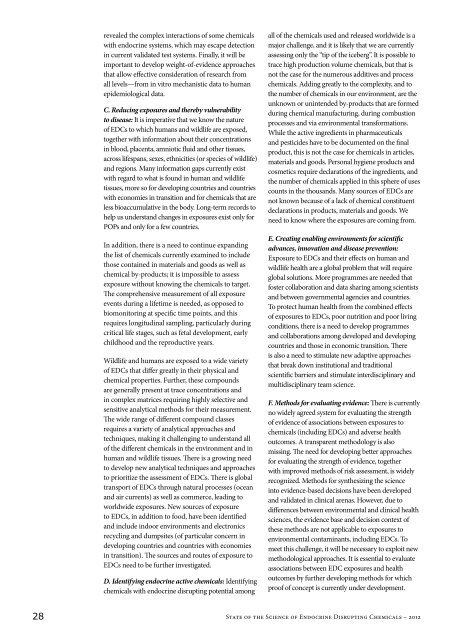Endocrine Disrupting Chemicals 2012 - World Health Organization
Endocrine Disrupting Chemicals 2012 - World Health Organization
Endocrine Disrupting Chemicals 2012 - World Health Organization
Create successful ePaper yourself
Turn your PDF publications into a flip-book with our unique Google optimized e-Paper software.
evealed the complex interactions of some chemicals<br />
with endocrine systems, which may escape detection<br />
in current validated test systems. Finally, it will be<br />
important to develop weight-of-evidence approaches<br />
that allow effective consideration of research from<br />
all levels—from in vitro mechanistic data to human<br />
epidemiological data.<br />
C. Reducing exposures and thereby vulnerability<br />
to disease: It is imperative that we know the nature<br />
of EDCs to which humans and wildlife are exposed,<br />
together with information about their concentrations<br />
in blood, placenta, amniotic fluid and other tissues,<br />
across lifespans, sexes, ethnicities (or species of wildlife)<br />
and regions. Many information gaps currently exist<br />
with regard to what is found in human and wildlife<br />
tissues, more so for developing countries and countries<br />
with economies in transition and for chemicals that are<br />
less bioaccumulative in the body. Long-term records to<br />
help us understand changes in exposures exist only for<br />
POPs and only for a few countries.<br />
In addition, there is a need to continue expanding<br />
the list of chemicals currently examined to include<br />
those contained in materials and goods as well as<br />
chemical by-products; it is impossible to assess<br />
exposure without knowing the chemicals to target.<br />
The comprehensive measurement of all exposure<br />
events during a lifetime is needed, as opposed to<br />
biomonitoring at specific time points, and this<br />
requires longitudinal sampling, particularly during<br />
critical life stages, such as fetal development, early<br />
childhood and the reproductive years.<br />
Wildlife and humans are exposed to a wide variety<br />
of EDCs that differ greatly in their physical and<br />
chemical properties. Further, these compounds<br />
are generally present at trace concentrations and<br />
in complex matrices requiring highly selective and<br />
sensitive analytical methods for their measurement.<br />
The wide range of different compound classes<br />
requires a variety of analytical approaches and<br />
techniques, making it challenging to understand all<br />
of the different chemicals in the environment and in<br />
human and wildlife tissues. There is a growing need<br />
to develop new analytical techniques and approaches<br />
to prioritize the assessment of EDCs. There is global<br />
transport of EDCs through natural processes (ocean<br />
and air currents) as well as commerce, leading to<br />
worldwide exposures. New sources of exposure<br />
to EDCs, in addition to food, have been identified<br />
and include indoor environments and electronics<br />
recycling and dumpsites (of particular concern in<br />
developing countries and countries with economies<br />
in transition). The sources and routes of exposure to<br />
EDCs need to be further investigated.<br />
D. Identifying endocrine active chemicals: Identifying<br />
chemicals with endocrine disrupting potential among<br />
all of the chemicals used and released worldwide is a<br />
major challenge, and it is likely that we are currently<br />
assessing only the “tip of the iceberg”. It is possible to<br />
trace high production volume chemicals, but that is<br />
not the case for the numerous additives and process<br />
chemicals. Adding greatly to the complexity, and to<br />
the number of chemicals in our environment, are the<br />
unknown or unintended by-products that are formed<br />
during chemical manufacturing, during combustion<br />
processes and via environmental transformations.<br />
While the active ingredients in pharmaceuticals<br />
and pesticides have to be documented on the final<br />
product, this is not the case for chemicals in articles,<br />
materials and goods. Personal hygiene products and<br />
cosmetics require declarations of the ingredients, and<br />
the number of chemicals applied in this sphere of uses<br />
counts in the thousands. Many sources of EDCs are<br />
not known because of a lack of chemical constituent<br />
declarations in products, materials and goods. We<br />
need to know where the exposures are coming from.<br />
E. Creating enabling environments for scientific<br />
advances, innovation and disease prevention:<br />
Exposure to EDCs and their effects on human and<br />
wildlife health are a global problem that will require<br />
global solutions. More programmes are needed that<br />
foster collaboration and data sharing among scientists<br />
and between governmental agencies and countries.<br />
To protect human health from the combined effects<br />
of exposures to EDCs, poor nutrition and poor living<br />
conditions, there is a need to develop programmes<br />
and collaborations among developed and developing<br />
countries and those in economic transition. There<br />
is also a need to stimulate new adaptive approaches<br />
that break down institutional and traditional<br />
scientific barriers and stimulate interdisciplinary and<br />
multidisciplinary team science.<br />
F. Methods for evaluating evidence: There is currently<br />
no widely agreed system for evaluating the strength<br />
of evidence of associations between exposures to<br />
chemicals (including EDCs) and adverse health<br />
outcomes. A transparent methodology is also<br />
missing. The need for developing better approaches<br />
for evaluating the strength of evidence, together<br />
with improved methods of risk assessment, is widely<br />
recognized. Methods for synthesizing the science<br />
into evidence-based decisions have been developed<br />
and validated in clinical arenas. However, due to<br />
differences between environmental and clinical health<br />
sciences, the evidence base and decision context of<br />
these methods are not applicable to exposures to<br />
environmental contaminants, including EDCs. To<br />
meet this challenge, it will be necessary to exploit new<br />
methodological approaches. It is essential to evaluate<br />
associations between EDC exposures and health<br />
outcomes by further developing methods for which<br />
proof of concept is currently under development.<br />
28 State of the Science of <strong>Endocrine</strong> <strong>Disrupting</strong> <strong>Chemicals</strong> – <strong>2012</strong>
















